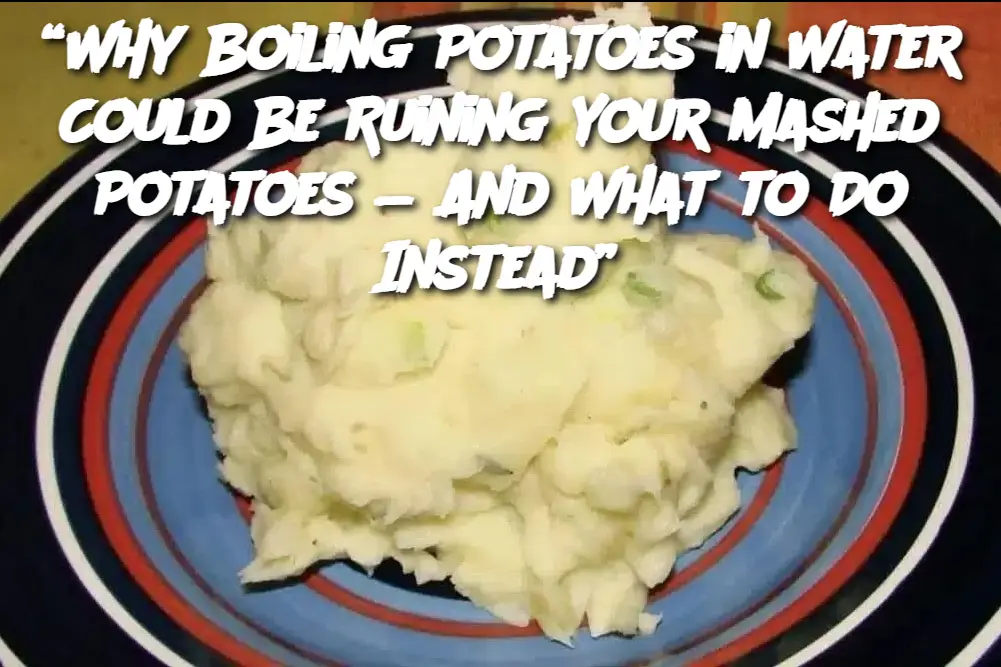-
Flavor loss:
Potatoes absorb water during boiling, which dilutes their natural flavor. Worse, salt and seasonings added afterward often sit on the surface rather than being infused inside. -
Nutrient drain:
Water-soluble vitamins like vitamin C and B6 leach into the cooking water — which is then poured down the drain. -
Soggy texture:
Overboiling leads to waterlogged potatoes, which make your mash gummy or gluey rather than fluffy. -
Wasted opportunity for creaminess:
Plain water doesn’t add anything to the taste or texture. You’re missing a chance to build flavor from the very first step.
« Preparation » (Better Ways to Cook Potatoes for Mashing)
Here are two alternative methods that avoid water and result in superior mashed potatoes:
🧈 Method 1: Simmer in Milk + Butter (or Broth)
-
Peel and cube your potatoes evenly.
-
Place them in a saucepan with enough whole milk, cream, or vegetable/chicken broth to cover.
-
Add 2–3 tablespoons of butter, a pinch of salt, and optional aromatics (like garlic or thyme).
-
Simmer gently (do not boil!) until fork-tender.
-
Mash directly in the liquid for ultra-creamy, flavorful results.
🔥 Method 2: Steam, Don’t Boil
-
Cut potatoes into chunks.
-
Steam in a basket over simmering water until tender.
-
Because they don’t absorb excess water, they mash lighter and fluffier — and retain more nutrients.
« Serving and Storage Tips »
-
Serve immediately, topped with a pat of butter or a drizzle of infused olive oil.
-
For extra richness, mix in roasted garlic, sour cream, or cream cheese after mashing.
-
Store in an airtight container in the fridge for up to 4 days. Reheat gently on the stove with a splash of milk or cream.
-
Avoid freezing mashed potatoes unless made with a high dairy content — it helps preserve texture.
« Variants » (Flavorful Add-Ins and Swaps)
-
Use bone broth or vegetable stock instead of milk for a dairy-free, umami-packed version.
-
Try buttermilk for a tangy twist and smoother texture.
-
Add herbs like rosemary, thyme, or chives for freshness.
-
Mix in grated Parmesan or sharp cheddar for a cheesy upgrade.
-
Stir in caramelized onions or sautéed mushrooms for depth and complexity.
FAQ
Q: Can I still use water if I have no other liquid?
A: Yes, but always salt the water well and avoid overboiling. Adding butter or olive oil after mashing can help bring back some richness.
Q: Why do potatoes get gluey when boiled?
A: Overcooked or overmixed potatoes release too much starch, making them sticky and dense. Steaming or simmering avoids this.
Q: What kind of potatoes are best for mashing?
A: Yukon Golds are ideal for creamy mashed potatoes. Russets also work well for light, fluffy results.
Q: Can I boil them in cream without curdling it?
A: Yes — just simmer gently and avoid high heat. Cream and milk boil quickly, so keep the temperature low and steady.
Q: Is steaming better than boiling?
A: Yes — steaming helps retain nutrients and prevents waterlogging, giving you a purer potato flavor and better texture.
